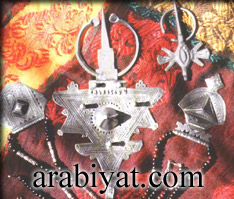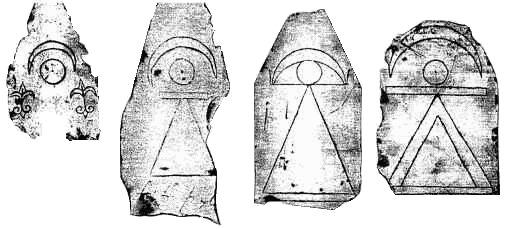Mooie dingen allemaal, Reader.

Even een paar dingen ertussen gooien. Ik was van plan wat uit te gaan zoeken over de titel 'Hand van god', maar ik was daar nog niet aan toegekomen. De godin Hathor had bijvoorbeeld deze titel, en ook de koningin Ahmose Nefertari, die betrokken was bij de stichting van de 18e dynastie en nog eeuwen als godin werd vereerd.
Ik dacht daarbij ook aan een relatie met zo''n handje van Fatima. Het heeft nog meer bekende namen, zoals Hand van Mirjam (zoals de joden het noemen), en natuurlijk Arabisch hamza, wat net als het Berberse woord 'vijf' betekent, of gewoon hand dus.
De naam Mirjam gaat trouwens terug op de Egyptische naam Merit-Amon (geliefde van Amon), wat ook een naam was van een dochter of kleindochter van Ahmose Nefertari.
Wat het oog betreft, vroeg ik me af of je het in verband kan brengen met de ogen uit de Egyptische godsdienst. Dus het Wadjet-oog (het cobra-oog, dat onder andere op de ureaus voorkomt), en de zon, die bijvoorbeeld oog van Ra etc. wordt genoemd.
Ik kopieer een klein stukje hierin, waardoor je je kan voorstellen dat het goed te associëren is met 'het boze' oog, of 'het alziend oog van god'. Sekhmet, de vernietigende leeuwengodin is een andere vorm van Hathor.
http://www.thekeep.org/~kunoichi/kunoic ... athor.html
Then Ra took on the shape of a man and became the first Pharaoh, ruling over the whole country for thousands and thousands of years, and giving such harvests that for ever afterwards the Egyptians spoke of the good things "which happened in the time of Ra".
But, being in the form of a man, Ra grew old. In time men no longer feared him or obeyed his laws. They laughed at him, saying: "Look at Ra! His bones are like silver, his flesh like gold, his hair is the colour of lapis lazuli!"
Ra was angry when he heard this, and he was more angry still at the evil deeds which men were doing in disobedience to his laws. So he called together the gods whom he had made - Shu and Tefnut and Geb and Nut - and he also summoned Nun. Soon the gods gathered about Ra in his Secret Place, and the goddesses also. But mankind knew nothing of what was happening, and continued to jeer at Ra and to break his commandments. Then Ra spoke to Nun before the assembled gods: "Eldest of the gods, you who made me; and you gods whom I have made: look upon mankind who came into being at a glance of my Eye. See how men plot against me; hear what they say of me; tell me what I should do to them. For I will not destroy mankind until I have heard what you advise."
Then Nun said: "My son Ra, the god greater than he who made him and mightier than those whom he has created, turn your mighty Eye upon them and send destruction upon them in the form of your daughter, the goddess Sekhmet."
Ra answered: "Even now fear is falling upon them and they are fleeing into the desert and hiding themselves in the mountains in terror at the sound of my voice."
"Send against them the glance of your Eye in the form Sekhmet!" cried all the other gods and goddesses, bowing before Ra until their foreheads touched the ground.
So at the terrible glance from the Eye of Ra his daughter Sekhmet came into being, the fiercest of all goddesses. Like a lion she rushed upon her prey, and her chief delight was in slaughter, and her pleasure was in blood. At the bidding of Ra she came into Upper and Lower Egypt to slay those who had scorned and disobeyed him: she killed them among the mountains which lie on either side of the Nile, and down beside the river, and in the burning deserts. All whom she saw she slew, rejoicing in slaughter and the taste of blood.
Presently Ra looked out over the land and saw what Sekhmet had done. Then he called to her, saying: "Come, my daughter, and tell me how you have obeyed my commands."
Sekhmet answered with the terrible voice of a lioness as she tears her prey: "By the life which you have given me, I have indeed done vengeance on mankind, and my heart rejoices."
Now for many nights the Nile ran red with blood, and Sekhmet's feet were red as she went hither and thither through all the land of Egypt slaying and slaying.
De ellende gaat nog wel even door, maar verder zonder oog.
Het symbool van Neith met de twee gekruiste pijlen is een van de oudste archeologische overblijfselen uit de faraotijd. Het is denk ik deze hiëroglyph, die de naam Merit-Neith voorstelt. Ik heb de info kwijt gemaakt, zal het er maar weer eens bij gaan zoeken.

Maar dit is volgens mij wel een dom argument:
"The Libyans did not understand the sign and changed it".
LIjkt mij ook. Jij noemde wel eens een of ander Berbers gebruik waarbij een lepel wordt aangekleed, die een bruid voorstelt of zo. Dat had volgens mij iets te maken met de ankh, Als dat zo is, zou je zeggen dat de betekenis prima is overgeleverd.
Deze sieraden heb ik trouwens gezien tijdens de tentoonstelling over Marokko in de Nieuwe Kerk in Amsterdam.

Het waren als ik het goed heb onthouden gespen, hoewel ik moet bekennen dat ik niet goed zie hoe hij dan werkt. Jammer genoeg weet ik niet goed meer wat het bijschrift was. In die tijd had ik ook geen fototoestel, onbegrijpelijk, want daar ben ik altijd mee gewapend.


























